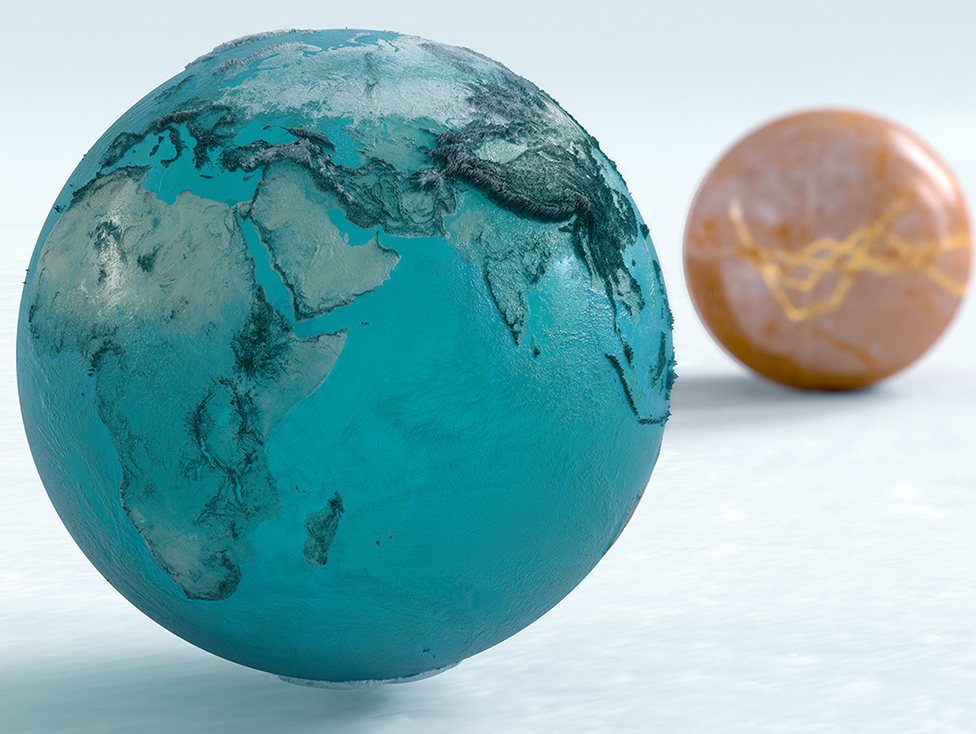- Article

- Global Research
- General Research Insights
- Disruptive technology
Space race continues…
- The space economy is estimated to be worth USD464bn
- The US and China currently lead in launches…
- …but India, the UK, and Europe are in the modern space race too
Enabling LEO tech
Whilst the House of Representatives in the US recently held a panel about unidentified anomalous phenomenon (UAPs), we have been focusing on more identifiable space technologies – namely low Earth orbit (LEO) satellites.
What’s an LEO? LEOs operate much closer to the Earth than traditional geostationary satellites, which means they have shorter orbital periods, taking about 90-120 minutes to go around the Earth. The downside of this approach is that any individual LEO can only communicate with a small portion of the Earth’s surface at any given time: it takes hundreds of them (a constellation) for full global coverage. But putting up a constellation is precisely what a number of companies and countries are now aiming to do.
4,700
LEOs in operation in May 2022 (Union of Concerned Scientists)
68.5%
Of operating satellites are US-run (Union of Concerned Scientists)
What can LEOs do? Much like traditional satellites, LEOs have a broad range of potential use cases. Telecommunications is perhaps the most widely known example, but the European Space Agency has claimed that space infrastructure has benefited a number of other sectors including meteorology, energy, insurance, transport, maritime, aviation, and urban development.
How much is at stake? The space economy was worth at least USD464bn in 2022 and it is likely to reach USD737bn within a decade, according to estimates from Euroconsult. North America and Asia currently dominate the sector, with Europe not far behind in terms of revenue share. In terms of satellites already in orbit, the US is far and away the leader, accounting for 68.5% of the total, according to non-profit group the Union of Concerned Scientists. On this measure, the US is followed by China (10.7%) and the UK (9.7%). However, India has placed the space sector as a key pillar of its aim to become a world technology superpower. And the UK government acquired a stake in OneWeb to bolster its space sector.
Why now? LEOs are not a new concept, but one key change in recent years is that the cost of space travel has fallen significantly. SpaceX’s Falcon Heavy rocket launched in 2018 at a cost of USD1,500 per kilogram, compared with USD5,400 per kilogram for NASA’s Saturn V rocket used between 1967 and 1973. SpaceX’s Starship rocket could lead to a further significant drop in costs by lowering the cost per kilogram to below USD100 by 2030.
Hurdles remain, however. In 2021 the European Space Agency estimated there were more than 130m pieces of debris larger than 1mm in orbit and this figure is even higher when considering debris that is too small to track. Even relatively small pieces of debris can cause LEO satellites serious damage when travelling at many kilometres per second. At some point, humans must clear up their space junk.
Would you like to find out more? Click here* to read a free to view version of the report.
To learn more about HSBC Global Research and how to subscribe, email us at askresearch@hsbc.com
*Please note that by clicking on this link you are leaving the HSBC Global Banking and Markets website, therefore please be aware that the external site policies will differ from our website terms and conditions and privacy policy. The next site will open in a new browser window or tab.
The following analyst(s), who is(are) primarily responsible for this document, certifies(y) that the opinion(s), views or forecasts expressed herein accurately reflect their personal view(s) and that no part of their compensation was, is or will be directly or indirectly related to the specific recommendation(s) or views contained in this research report: Henry Ward, Davey Jose and Nicolas Cote-Colisson
This document has been issued by the Research Department of HSBC.
HSBC and its affiliates will from time to time sell to and buy from customers the securities/instruments, both equity and debt (including derivatives) of companies covered in HSBC Research on a principal or agency basis or act as a market maker or liquidity provider in the securities/instruments mentioned in this report.
Analysts, economists, and strategists are paid in part by reference to the profitability of HSBC which includes investment banking, sales & trading, and principal trading revenues.
Whether, or in what time frame, an update of this analysis will be published is not determined in advance.
For disclosures in respect of any company mentioned in this report, please see the most recently published report on that company available at www.hsbcnet.com/research.
Additional disclosures
- This report is dated as at 28 July 2023.
- All market data included in this report are dated as at close 27 July 2023, unless a different date and/or a specific time of day is indicated in the report.
- HSBC has procedures in place to identify and manage any potential conflicts of interest that arise in connection with its Research business. HSBC's analysts and its other staff who are involved in the preparation and dissemination of Research operate and have a management reporting line independent of HSBC's Investment Banking business. Information Barrier procedures are in place between the Investment Banking, Principal Trading, and Research businesses to ensure that any confidential and/or price sensitive information is handled in an appropriate manner.
- You are not permitted to use, for reference, any data in this document for the purpose of (i) determining the interest payable, or other sums due, under loan agreements or under other financial contracts or instruments, (ii) determining the price at which a financial instrument may be bought or sold or traded or redeemed, or the value of a financial instrument, and/or (iii) measuring the performance of a financial instrument or of an investment fund.
This document has been issued by HSBC Bank plc, which has based this document on information obtained from sources it believes to be reliable but which it has not independently verified. Neither HSBC Bank plc nor any member of its group companies (“HSBC”) make any guarantee, representation or warranty nor accept any responsibility or liability as to the accuracy or completeness of this document and is not responsible for errors of transmission of factual or analytical data, nor is HSBC liable for damages arising out of any person’s reliance on this information. The information and opinions contained within the report are based upon publicly available information at the time of publication, represent the present judgment of HSBC and are subject to change without notice.
This document is not and should not be construed as an offer to sell or solicitation of an offer to purchase or subscribe for any investment or other investment products mentioned in it and/or to participate in any trading strategy. It does not constitute a prospectus or other offering document. Information in this document is general and should not be construed as personal advice, given it has been prepared without taking account of the objectives, financial situation or needs of any particular investor. Accordingly, investors should, before acting on it, consider the appropriateness of the information, having regard to their objectives, financial situation and needs. If necessary, seek professional investment and tax advice.
The decision and responsibility on whether or not to purchase, subscribe or sell (as applicable) must be taken by the investor. In no event will any member of the HSBC group be liable to the recipient for any direct or indirect or any other damages of any kind arising from or in connection with reliance on any information and materials herein.
Past performance is not necessarily a guide to future performance. The value of any investment or income may go down as well as up and you may not get back the full amount invested. Where an investment is denominated in a currency other than the local currency of the recipient of the research report, changes in the exchange rates may have an adverse effect on the value, price or income of that investment. In case of investments for which there is no recognised market it may be difficult for investors to sell their investments or to obtain reliable information about its value or the extent of the risk to which it is exposed. Some of the statements contained in this document may be considered forward looking statements which provide current expectations or forecasts of future events. Such forward looking statements are not guarantees of future performance or events and involve risks and uncertainties. Actual results may differ materially from those described in such forward-looking statements as a result of various factors.
This document is for information purposes only and may not be redistributed or passed on, directly or indirectly, to any other person, in whole or in part, for any purpose. The distribution of this document in other jurisdictions may be restricted by law, and persons into whose possession this document comes should inform themselves about, and observe, any such restrictions. By accepting this report, you agree to be bound by the foregoing instructions. If this report is received by a customer of an affiliate of HSBC, its provision to the recipient is subject to the terms of business in place between the recipient and such affiliate. The document is intended to be distributed in its entirety. Unless governing law permits otherwise, you must contact a HSBC Group member in your home jurisdiction if you wish to use HSBC Group services in effecting a transaction in any investment mentioned in this document.
Certain investment products mentioned in this document may not be eligible for sale in some states or countries, and they may not be suitable for all types of investors. Investors should consult with their HSBC representative regarding the suitability of the investment products mentioned in this document.
HSBC and/or its officers, directors and employees may have positions in any securities in companies mentioned in this document. HSBC may act as market maker or may have assumed an underwriting commitment in the securities of companies discussed in this document (or in related investments), may sell or buy securities and may also perform or seek to perform investment banking or underwriting services for or relating to those companies and may also be represented on the supervisory board or any other committee of those companies.
From time to time research analysts conduct site visits of covered issuers. HSBC policies prohibit research analysts from accepting payment or reimbursement for travel expenses from the issuer for such visits.
HSBC Bank plc is registered in England No 14259, is authorised by the Prudential Regulation Authority and regulated by the Financial Conduct Authority and the Prudential Regulation Authority and is a member of the London Stock Exchange. (070905)
© Copyright 2023, HSBC Bank plc, ALL RIGHTS RESERVED. No part of this publication may be reproduced, stored in a retrieval system, or transmitted, on any form or by any means, electronic, mechanical, photocopying, recording, or otherwise, without the prior written permission of insert issuing entity name. MCI (P) 017/01/2023, MCI (P) 027/10/2022
Global Research
HSBC Global Research provides information, insights and thought-provoking ideas.



